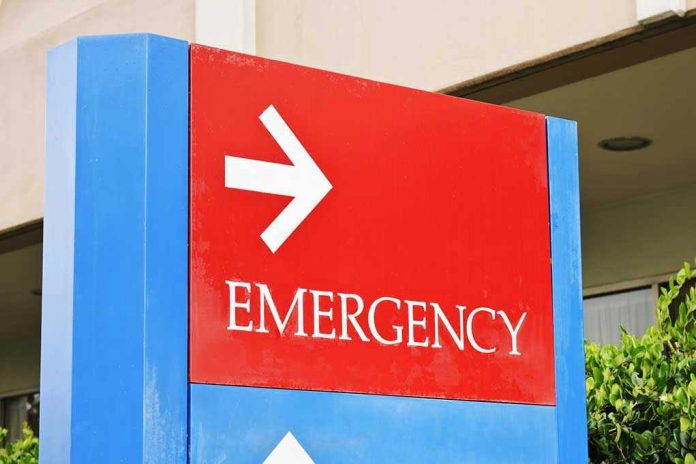
What happens in the seconds after a fall can change the rest of your life—and that’s not just for the “old folks,” so stick around to find out what ER doctors wish you’d do before you even think about hopping up and brushing it off.
At a Glance
- Falls are the number one cause of serious injury and death in adults over 65.
- ER doctors warn that everyone, regardless of age, should take specific steps after a fall to avoid hidden complications.
- Most falls in older adults can be prevented with exercise, home safety tweaks, and medication reviews.
- National health agencies now push for individualized, multi-pronged prevention plans and faster emergency response.
Why a Fall Can Be a Life Changer—For Everyone
Falls aren’t just a punchline for slapstick comedy or a rite of passage for daredevil toddlers. They are the number one reason older adults end up in the ER, and they’re responsible for more injuries and deaths in the 65+ crowd than anything else. In 2021 alone, nearly 3 million Americans took an unplanned trip to the emergency room after a fall, and 38,000 didn’t survive. But here’s the plot twist: what you do in the first moments after a fall can mean the difference between a funny story and a lifelong struggle. ER doctors say it’s not just about broken bones—falls can cause hidden injuries, from brain bleeds to slow-building infections, especially if you’re on medications like blood thinners. And if you think you’re too young to worry, think again. The experts agree—everyone needs a post-fall action plan, and the sooner you start, the better your odds of bouncing back.
So, what’s happening behind the scenes? As the population ages, more people are living longer and on their own. That means more of us—yes, even you—are in the fall danger zone. The CDC, National Council on Aging, and a parade of public health experts have been sounding the alarm for years, but the numbers just keep climbing. Why? Because falls aren’t just about weak legs or bad luck. They’re a complex cocktail of slippery floors, dim lighting, medication side effects, and health conditions that sneak up on you. It’s not just about avoiding a banana peel; it’s about stacking the odds in your favor long before gravity gets its shot at you.
What Every ER Doctor Wishes You’d Do After a Fall
The clock starts ticking the moment you hit the ground. Dr. Joe Whittington, an ER physician who’s seen it all, says the worst thing you can do is pop up too fast or try to play hero. First, take a breath—and a beat. Scan your body for pain, dizziness, or anything that feels off. If you hit your head, are on blood thinners, or feel even a little confused, call for help immediately. Dr. Jordan Wagner, another ER pro, warns that head injuries can turn lethal in hours, not days, and that adrenaline can mask serious damage. If you’re alone, get to a phone and don’t be shy about dialing 911. Even if you feel fine, monitor for new symptoms like headache, vision changes, or trouble moving. As they say in medicine, “When in doubt, check it out.”
Family members and caregivers are part of the emergency team, too. They should watch for changes in behavior, balance, or speech in the hours and days after a fall. Dr. Jessica Singh, formerly in the ER trenches, says to pay extra attention if you’re on medications that thin the blood or if you have other health problems. And don’t just chalk it up to “getting older”—every fall deserves a why. Was it a loose rug, a new medication, or a dizzy spell? Figuring that out can be the key to preventing round two.
The Prevention Playbook: How to Dodge the Next Fall
If you think fall prevention means bubble-wrapping your house and never leaving the sofa, prepare to be pleasantly surprised. The U.S. Preventive Services Task Force (USPSTF) and the CDC both agree: the number one thing you can do is stay active. Exercise, especially programs that target strength and balance, slashes your risk of falling. It’s not about becoming a gym rat—it’s about moving enough to keep your legs and reflexes sharp. Next, take a hard look at your home. Are the lights bright enough? Are there grab bars in the bathroom? Is that throw rug really worth a hospital bill?
Medication reviews are another secret weapon. Many prescriptions—especially those for sleep, blood pressure, or anxiety—can make you dizzy or slow your reaction time. Ask your doctor or pharmacist for a fall risk checkup with every new prescription. And don’t go it alone. Community programs, local health departments, and even national organizations like the NCOA offer classes and resources that make getting safer a group effort. The best part? Most falls are preventable, and it’s never too late (or too early) to start tipping the odds your way.
The Hidden Costs and the Future of Fall Prevention
Beyond the bruises, falls come with an eye-watering price tag—over $80 billion in healthcare costs per year and rising fast. Every fall can mean lost independence, new fears, and, for families, a ripple effect of stress and financial strain. That’s why public health agencies are pushing harder than ever for prevention. New guidelines call for individualized, multi-pronged plans tailored to each person’s risks, not one-size-fits-all checklists. Local governments and health systems are investing in smarter home designs, better access to exercise programs, and better education for families and caregivers. But the biggest difference still starts at home—with you, your awareness, and your willingness to act.
So, the next time you—or anyone you know—takes a tumble, remember: every second counts, every symptom matters, and every fall is a chance to rewrite the ending. Don’t just get back up. Get smarter, get safer, and stack the odds in your favor for the sequel.







